Designing Spaces, Defining Lifestyles!
With decades of expertise, our team of architects and interior designers crafts sophisticated interiors rooted in design excellence and sustainable practices.

In the world of commercial interior design, few spaces are as overlooked—and yet as potent—as the pre-reception zone. These are the transitional, often uncelebrated areas where the first, subconscious impressions of a brand begin to form: the elevator lobby, the corridor leading to the main door, or that silent pause just before the reception desk comes into view. At Blucap Interiors, we believe that these fleeting spaces offer a unique opportunity to tell a story before a single word is spoken.
The moment someone steps out of an elevator or ascends a flight of stairs into an office premises, their senses are already activated. There’s a brief moment of pause—anticipation, curiosity, even assessment. It’s a silent moment that holds immense design power.
At Blucap Interiors, we approach this transitional space as more than a buffer—it’s a canvas. One that sets the emotional tone for what follows. Does it evoke calm? Does it suggest clarity, warmth, luxury, or innovation? These are emotional cues that speak far louder than signage or taglines.
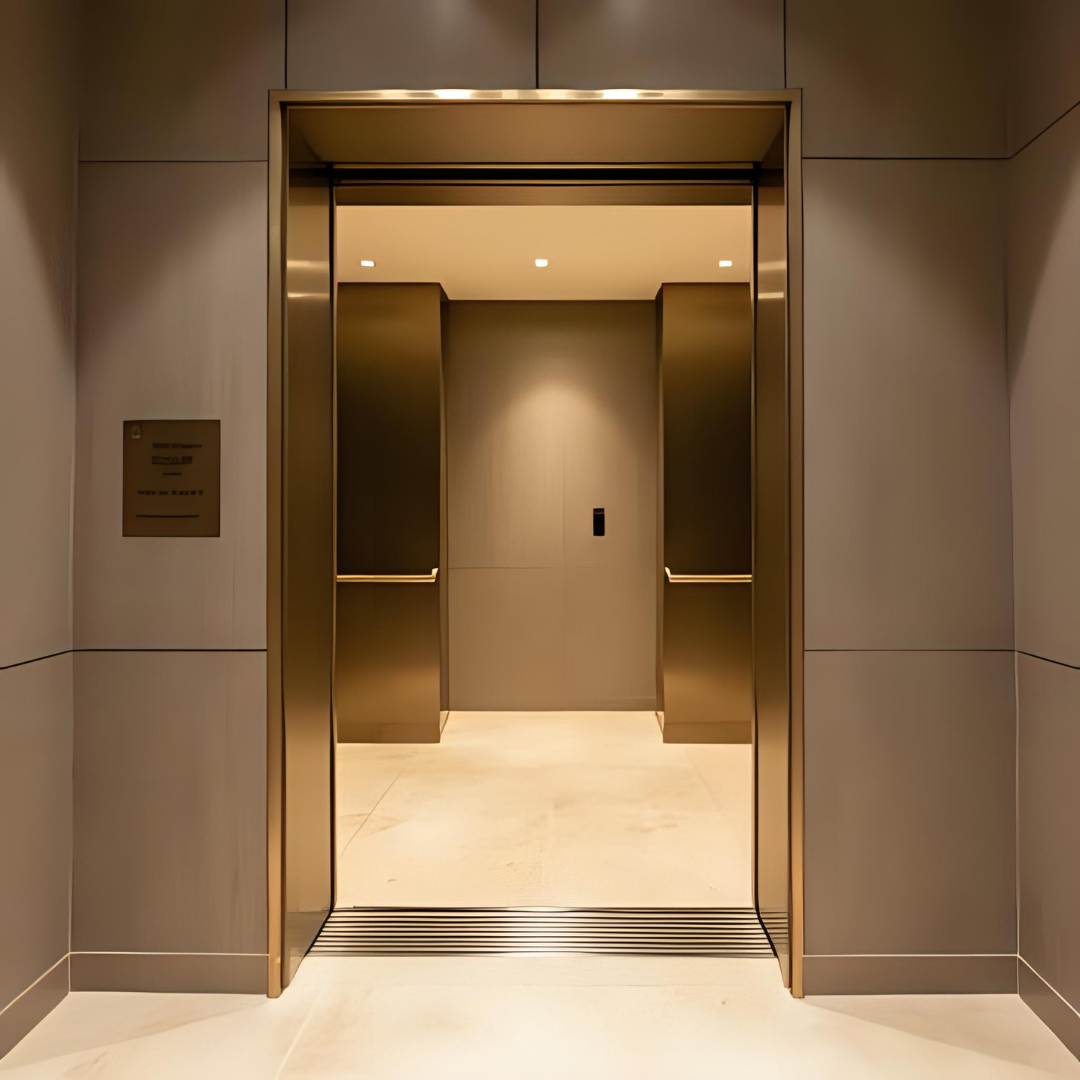
Why are these areas often neglected? Because they fall between categories. They are not quite public, yet not entirely private. They are not the reception proper, yet they are not anonymous corridors either. And that’s exactly where their value lies.
Blucap Interiors treats these in-between spaces as high-value real estate. They are the brand’s whisper before its voice. Through subtle material transitions, tonal lighting, curated art, and intentional flooring details, we craft an arrival experience that feels seamless and immersive—often without the visitor realizing what’s at play.
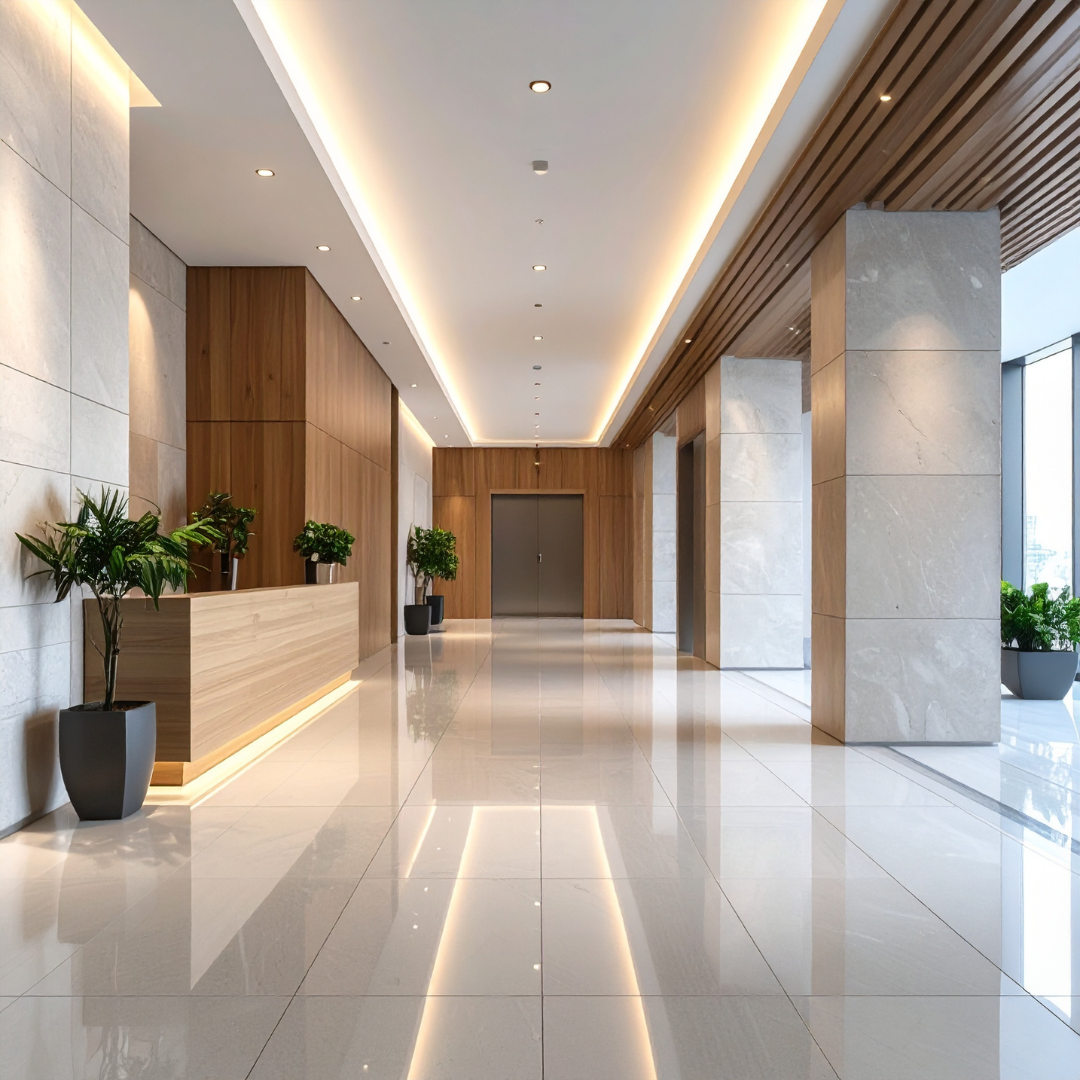
In pre-reception zones, tactile language becomes key. The cool texture of brushed metal, the richness of warm wood panelling, the muted elegance of travertine underfoot—each element speaks in quiet tones of sophistication or confidence.
At Blucap Interiors, we select materials for these spaces not only for durability, but also for narrative. A matte black wall might nod to modernity and discretion. A velvet-clad bench may hint at hospitality. A cascading wall sculpture might mirror the brand’s dynamic identity. These choices are not decorative—they are communicative.
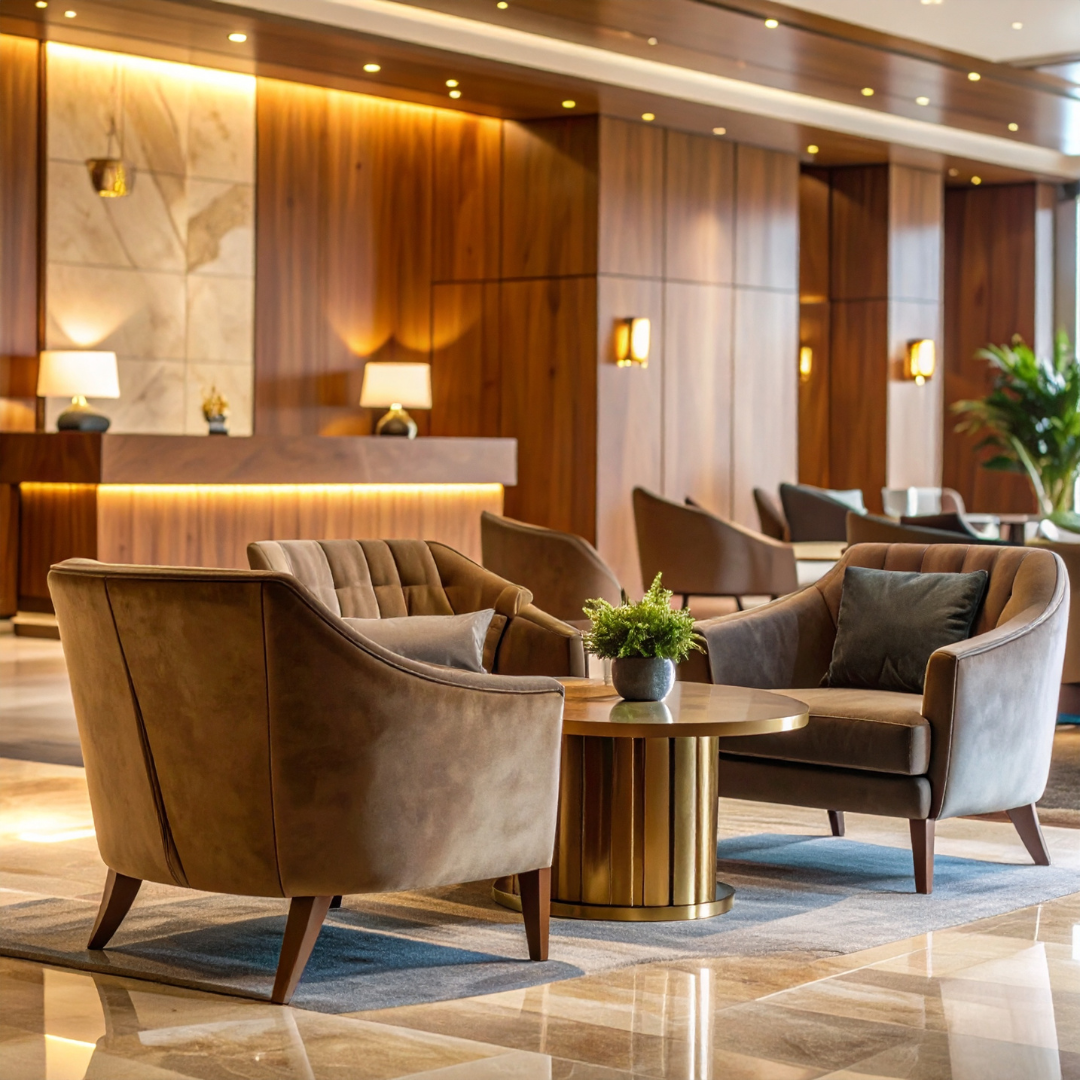
Lighting in pre-reception zones is often an afterthought. At Blucap Interiors, we treat it as choreography. We use light to guide the eye, to invite movement, and to offer moments of pause. A carefully positioned downlight on a textured wall can become a focal point. A concealed LED strip beneath a floating bench adds subtle drama. We avoid over-illumination; instead, we let shadows play their part.
Movement, too, is key. The way a person naturally walks through this space—whether they slow down, glance around, or stride ahead—can be influenced by spatial composition. At Blucap, our layouts are intentional: they invite grace, not haste.
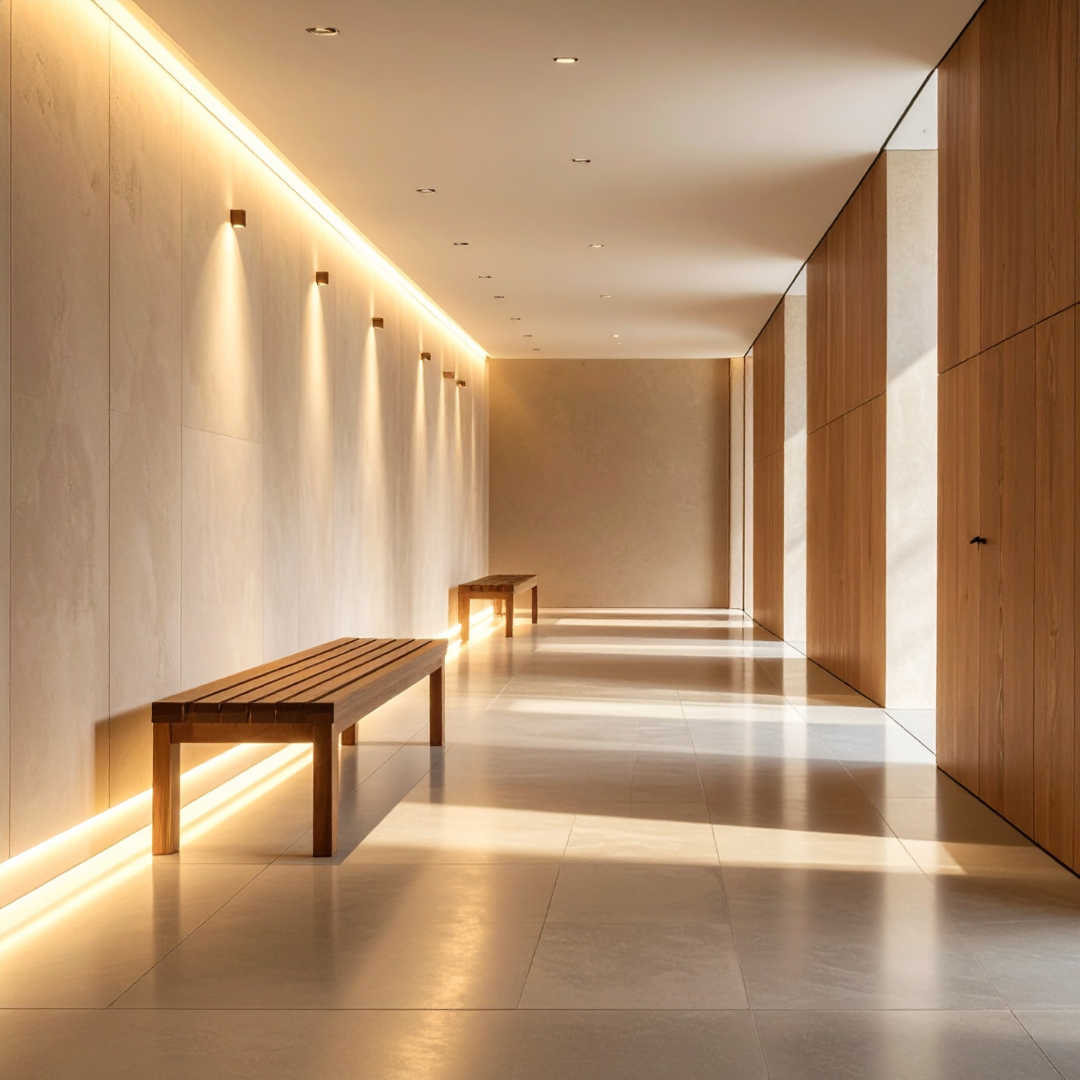
Perhaps the most refined aspect of designing a pre-reception zone is the ability to express brand identity without relying on logos or signboards. The identity is felt, not announced. It’s in the palette, the textures, the restraint, and the composition.
This is a philosophy that Blucap Interiors brings to every commercial project: branding through atmosphere. Whether it’s a legal firm that demands gravitas or a creative studio that thrives on edge and fluidity, we embed personality into the space in ways that are elevated and enduring.
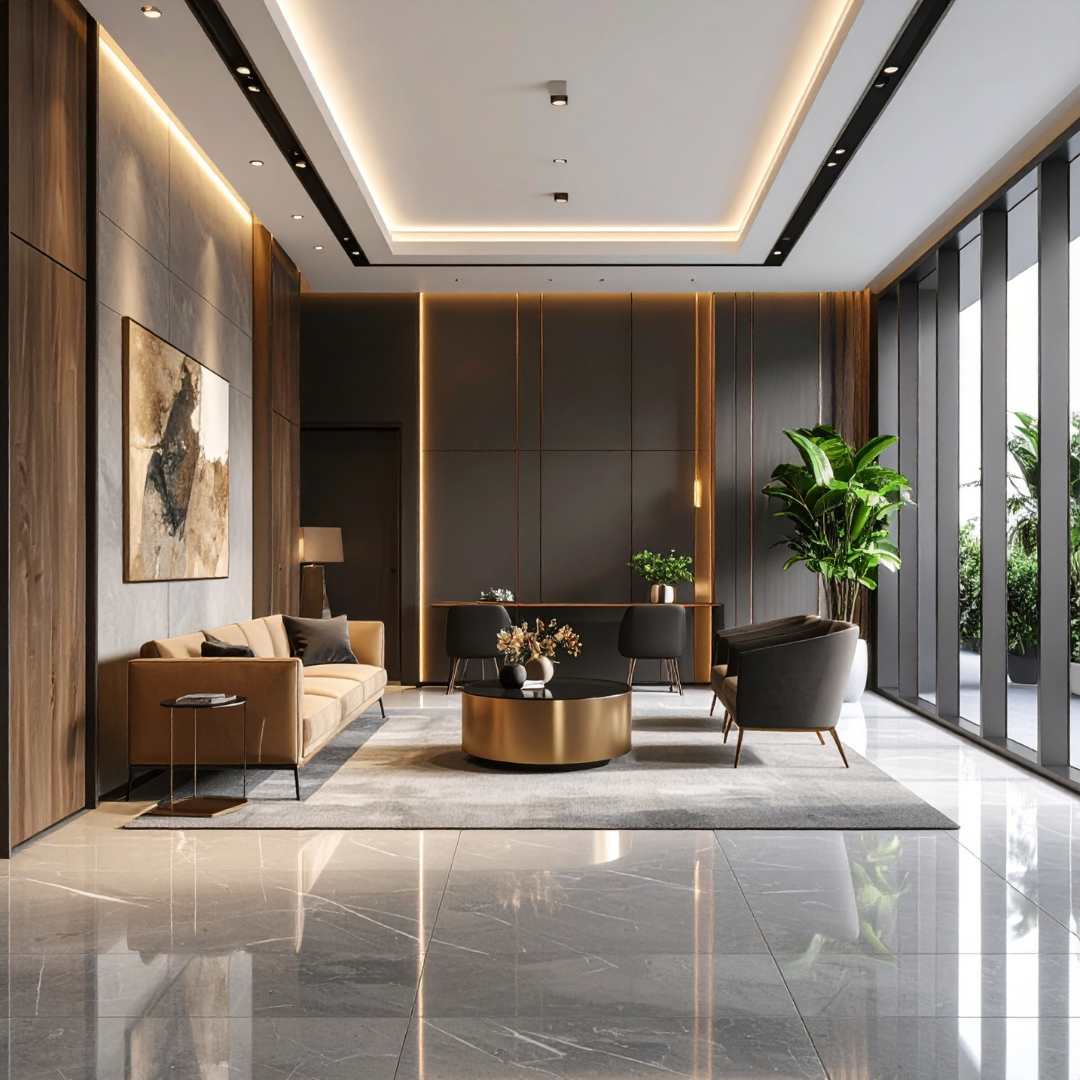
In a post-pandemic world where hybrid work models and flexible offices are the norm, fewer people are walking through traditional reception doors every day. But when they do—clients, investors, collaborators, talent—the experience must be precise. Memorable. Intentional.
Blucap Interiors understands that it’s often the first few seconds, in the pre-reception zone, that define how the rest of the office is perceived. Not as an afterthought, but as the opening line of a beautifully written chapter.
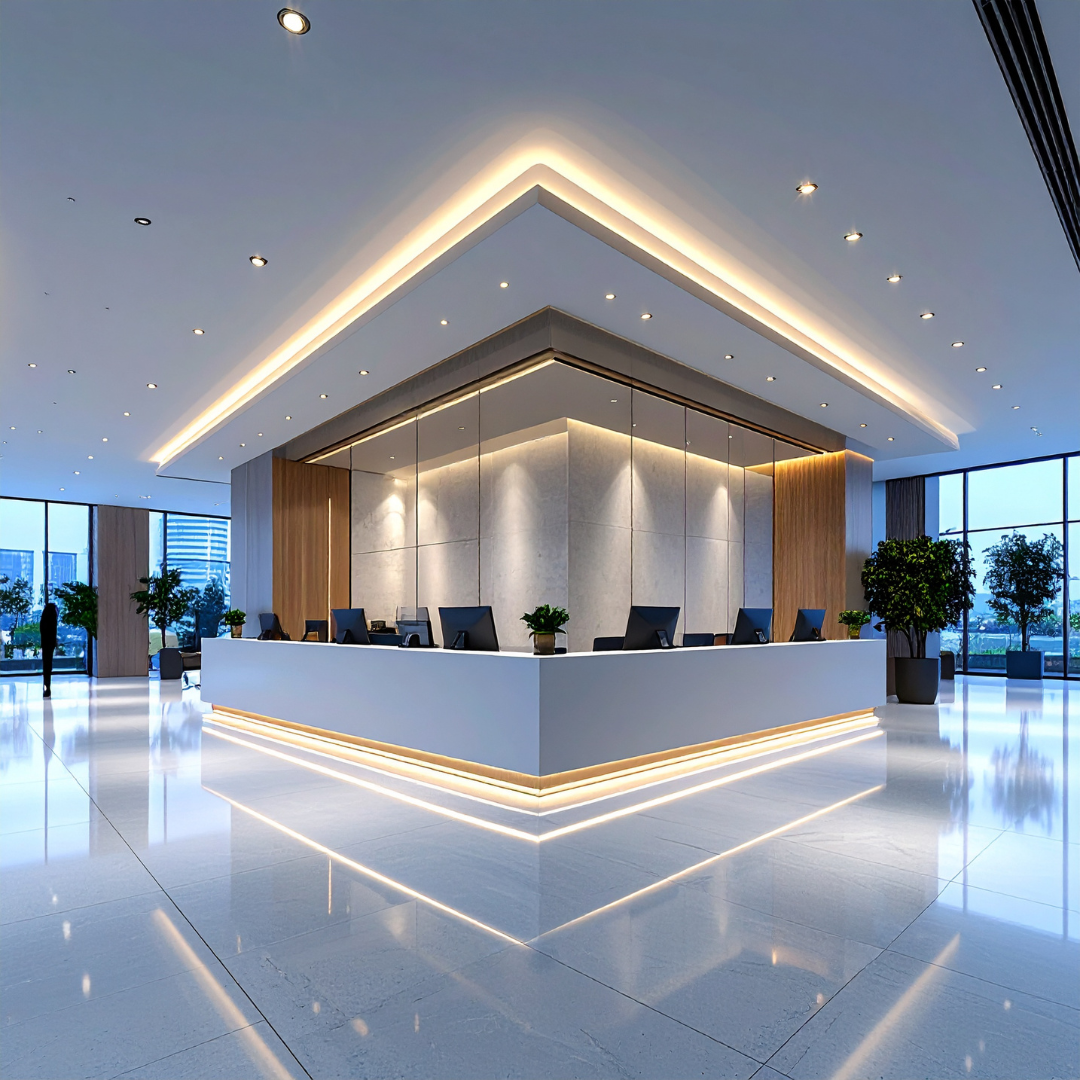
The pre-reception space is no longer just a path to the main attraction—it is, in itself, a refined statement of presence and poise. At Blucap Interiors, we believe that great design begins before the first handshake, before the first greeting, and before the first desk. It begins the moment someone enters your world—quietly, effortlessly, and with intention.

In the age of visual storytelling and experience-driven businesses, a salon is no longer just a space for beauty treatments. It is a living, breathing brand expression—one that begins long before the first snip of the scissors. At Blucap Interiors, we believe that interior design is not a backdrop but a bold, strategic communicator of your salon’s identity.

From the moment a client steps through your doors, every element—lighting, layout, material palette, even scent—speaks volumes. Is your salon edgy and fashion-forward, or tranquil and restorative? Is it a high-end atelier for the discerning elite or a buzzing creative hub for the trend-savvy crowd?
Blucap Interiors approaches salon design as a narrative, where every surface and corner plays a role in reinforcing your brand voice. Minimalist brass-framed mirrors, a terrazzo floor, or velvet reception seating aren’t just choices—they are statements.

With increasing saturation in the salon industry, visual differentiation has become crucial. Your interiors offer one of the most powerful tools to carve out a unique aesthetic signature. At Blucap Interiors, we translate your brand values into spatial gestures: open layouts that suggest transparency, raw textures that convey authenticity, or plush finishes that whisper luxury.
Think of the interiors as a mood board made physical—a place where clients feel your brand without needing a brochure.

Branding isn’t only visual. It’s also about how a space feels. Lighting that flatters both the client and the craft, the spatial choreography that allows stylists to flow effortlessly, and soundscapes that calm or energize—these are all parts of a well-considered design vocabulary. Blucap Interiors collaborates closely with salon owners to craft immersive environments where branding is not imposed, but experienced.

In today’s digital-first world, your interior must translate well both IRL and on-screen. A custom backdrop for post-glam selfies. A waiting area that looks like it belongs in a boutique hotel. A light-drenched corner where every hair color pops on camera. At Blucap Interiors, we understand that design is no longer static—it moves, posts, reels, and stories.

Too often, salon interiors are treated as aesthetic afterthoughts. But design, when done right, is brand strategy in spatial form. It can elevate perceived value, build loyalty, and even drive revenue. A well-designed salon doesn’t just attract clients—it makes them stay longer, spend more, and return often.
What sets Blucap Interiors apart is our ability to design not just beautiful salons, but iconic ones. Our approach is equal parts artistic intuition and business insight. Whether you’re a boutique salon launching your first outpost or a fast-scaling chain looking for a cohesive identity across locations, we help you translate vision into space.

Your salon is your brand’s stage. Every material, every lighting decision, every layout choice tells a story. Make sure it’s the right one. Because in today’s hyper-aesthetic world, your interiors don’t just reflect your brand—they define it.
At Blucap Interiors, we don’t just design salons. We design identities you can walk into.

In the shifting landscape of post-pandemic work culture, the concept of the “third space” has quietly but profoundly redefined itself. Traditionally nestled somewhere between home and office, third spaces were once the realm of leisure — a cozy café, a neighborhood bookstore, a boutique co-working lounge. Today, however, that line is blurring. Cafés, once casual refueling stations, are being reimagined as serious contenders in the evolving architecture of work.
At Blucap Interiors, we’re witnessing a significant design pivot: cafés are no longer just about ambience and artisanal espresso. They are becoming extensions of the modern workplace — agile, adaptive, and deeply intentional.

The rise of hybrid work has not only unmoored employees from fixed office desks but also reshaped their expectations of what a productive environment looks and feels like. The modern professional craves autonomy — not just in schedule, but in space. Cafés, in this context, offer a fluid yet curated alternative to both the home office and the corporate cubicle.
Designers at Blucap Interiors are now being asked questions that would have seemed unusual five years ago:
“How can a café be zoned for silent work without alienating casual customers?”
“Can power outlets and ambient lighting be woven into a space without disrupting its charm?”
This is the new design brief — and it demands more than aesthetic intuition. It requires strategic spatial thinking.

The hallmark of a work-friendly café lies in its ability to accommodate multiple user states: solo focus, collaborative discussion, casual drop-ins, and extended stays. The answer lies in smart zoning — creating micro-environments within a unified design language.
At Blucap Interiors, we often advocate for layered seating formats: bar stools near windows for quick visits, communal tables for coworking energy, and plush nooks for deep work. Lighting is dialed down to a warmer spectrum in zones where customers are likely to stay longer, while task lighting is subtly integrated near individual seating spots.
Sound scaping is another design frontier. Acoustic panels disguised as wall art, texture-rich furnishings, and carefully selected playlists all contribute to an environment that buzzes — but never overwhelms.

For cafés aiming to embrace this shift, designing for longer dwell times is both a challenge and an opportunity. Wi-Fi is only part of the equation. The real question is: does the space invite someone to stay? At Blucap Interiors, we often refer to this as “passive hospitality” — where every detail, from ergonomic chair backs to ambient temperature, subtly communicates that the customer is welcome to linger.
Materials, too, play a role. Tables must be both beautiful and functional — wide enough for a laptop and a latte, resistant to spills, and acoustically absorptive. Finishes that age gracefully under constant use are not just desirable; they are essential.

What makes this trend truly interesting is how it intersects with business strategy. Cafés that design for the work-from-anywhere generation are not simply investing in aesthetics — they are redefining their revenue models. Longer visits may reduce customer turnover, but they increase order frequency and brand loyalty.
Blucap Interiors works with café owners to decode this balance: how to design a space that nurtures a loyal, working clientele without alienating the casual brunch crowd. It’s less about compromise and more about thoughtful curation — designing not just for function or beauty, but for behaviour.

As the formal office recedes and home becomes increasingly sacred, the third space — particularly the well-designed café — stands to become the new frontier of productivity. Not because it’s a substitute, but because it offers something both home and office cannot: neutrality, flexibility, and design-led intent.
At Blucap Interiors, we believe this shift is not a fleeting trend but a signpost of a deeper cultural realignment. The café-as-office is not merely a clever repurposing of space. It’s a new typology — one that deserves to be designed with the same seriousness, sophistication, and foresight we typically reserve for boardrooms and bedrooms alike.


In a world where wellness has transcended treatment and entered the realm of lifestyle, clinics are undergoing a quiet, powerful revolution. No longer bound by the sterile aesthetics of white walls, antiseptic odours, and institutional lighting, a new breed of wellness entrepreneurs is demanding something radically different: clinics that don’t feel like clinics at all. And at the forefront of this paradigm shift is Blucap Interiors, redefining the spatial narrative for modern healing environments.

At Blucap Interiors, we’ve observed a striking movement among the new generation of wellness founders—those helming skin clinics, biohacking labs, integrative therapy studios, and longevity centres. These are not clinical institutions, but sanctuaries of experience, places that value emotion, memory, and aesthetics as much as they value diagnosis. The brief is often unspoken but deeply understood: design me a space where the client forgets they’re here for a procedure.

This is the heart of the anti-clinic philosophy. It begins with a rejection of clinical tropes and moves toward immersive spatial storytelling. No reception counters that look like airport check-ins. No surgical-grade overhead lights. No cookie-cutter furniture out of a medical catalogue. Instead, Blucap Interiors crafts spaces where intentional ambiguity reigns—where the entry sequence might feel more like a boutique hotel, an art gallery, or even a living room drenched in diffused daylight and textural serenity.

Lighting becomes a medium of emotional calibration. We often favour warm, ambient sources layered with low-level accent lighting, creating a softened visual field that reduces anxiety from the moment of entry. Mirrors are placed strategically—not to scrutinize imperfections, but to reflect light, open space, and frame one’s best angles post-treatment. At Blucap Interiors, we believe that good design should not only complement skin tone—it should elevate the client’s sense of self.

Materials, too, are chosen with care. Instead of harsh laminates and synthetic finishes, we gravitate toward tactile luxury—fluted oak, travertine, brushed brass, hand-troweled lime plaster, and velvet that hushes every movement. These are materials that whisper wellness rather than declare sterility. We call it emotional texture—and it’s as critical to the healing process as the treatment protocol itself.

But the anti-clinic ethos goes beyond visual softness. It is about dissolving hierarchy. In many of the spaces designed by Blucap Interiors, doctors do not sit behind intimidating desks. Instead, they share softly upholstered seating nooks with their clients, fostering intimacy and collaboration. Consultation rooms resemble personal lounges, and corridors are intentionally curved to avoid confrontational sightlines—every detail contributing to a gentle, intuitive flow.

This new generation of wellness entrepreneurs isn’t interested in the old model of “clinical authority.” They’re building brands rooted in care, ritual, and sensorial connection—and their spaces need to reflect that. Blucap Interiors approaches each of these projects with a tailored hand, distilling the founder’s philosophy into a spatial identity that speaks without words.

And perhaps that’s the defining marker of the anti-clinic: it’s a place where the design doesn’t need to remind you what it is. It simply allows you to feel—comfortable, safe, seen. In a time when wellness is both science and soul, that, we believe, is the true architecture of healing.

In today’s evolving commercial real estate landscape, interior design is no longer considered a decorative afterthought. Instead, it plays a pivotal role in shaping a property’s desirability, functionality, and long-term leasing value. Thoughtfully designed interiors can elevate a commercial space from merely functional to truly aspirational—transforming vacant units into coveted addresses. At Blucap Interiors, we believe that intelligent design decisions have the power to directly impact leasing success.
Before a potential tenant examines the floor plan or reviews the lease terms, they respond—often subconsciously—to the feeling evoked by the space. A well-designed lobby or reception area, layered with tactile finishes, curated lighting, and thoughtful spatial planning, immediately communicates professionalism and prestige. These are not superficial aesthetics; they are vital first impressions that influence leasing decisions.

In markets where location and square footage are often comparable across buildings, interior design becomes the key differentiator. Prospective tenants gravitate toward spaces that reflect innovation, efficiency, and adaptability. Strategic design—such as open-plan flexibility, breakout zones, integrated technology, and brand-neutral yet stylish palettes—can make a property stand out in a sea of sameness. This often translates into shorter vacancy periods and stronger tenant commitments.

Modern businesses seek spaces that evolve with them. Interior layouts that allow for modular use, shifting teams, or hybrid work environments are significantly more attractive in the current climate. Flexible design empowers tenants to grow within the space, reducing churn and increasing long-term occupancy. Blucap Interiors encourages adaptable configurations that support diverse workplace cultures and operational models, making spaces relevant not just for today—but for the future.

Today’s tenants—especially large enterprises and forward-thinking brands—are increasingly drawn to environmentally responsible buildings. Interior design that incorporates sustainable materials, efficient lighting systems, natural ventilation, and biophilic elements not only contributes to lower operating costs but also supports a company’s ESG commitments. Sustainable design adds intrinsic value to a space, making it more marketable and more aligned with the priorities of modern tenants.

Comfort and functionality are no longer optional—they are essential. Spaces that consider the daily experiences of those who use them tend to retain tenants longer. Acoustic optimization, access to natural light, intuitive circulation, and wellness-focused zones are all part of a human-centric approach that adds measurable leasing value. When employees thrive in a space, so does the business—and that makes the space more desirable.

Interior design is also a powerful branding tool. For commercial landlords and developers, the design language of a building speaks volumes about the kind of tenants it attracts. Spaces that reflect sophistication, energy, creativity, or calm will draw aligned brands looking to extend their own identity through the workplace. At Blucap Interiors, we focus on creating such environments—designs that tell a story, while offering the flexibility for tenants to bring their own narratives to life.

Interior design is far more than visual enhancement—it’s a value multiplier. It contributes to higher leasing rates, faster occupancy, and improved tenant satisfaction. For property developers and commercial landlords, investing in high-quality, intentional design is an investment in the long-term profitability and reputation of the asset.
At Blucap Interiors, we see interior design as a strategic tool—one that bridges architecture, branding, and business. In a world where workspace experience is part of what companies sell to their clients and teams, design has become not just relevant—but essential.

In an era where diversity and inclusion are not just values but imperatives, interior design plays a pivotal role in shaping how these principles come to life within the workplace. At Blucap Interiors, we believe that an office should be more than just visually compelling—it should be a space that welcomes every individual, regardless of their physical, sensory, or cognitive abilities.

While accessibility standards such as those laid out by the ADA (Americans with Disabilities Act) or India’s Rights of Persons with Disabilities Act provide a solid foundation, truly inclusive design goes several steps further. It’s not about ticking boxes; it’s about anticipating needs and designing with empathy.
Blucap Interiors approaches accessibility not as an afterthought but as an integrated design philosophy—where every choice, from flooring to furniture, from signage to lighting, contributes to creating an inclusive spatial experience.
Wide corridors, unobstructed pathways, and seamless transitions between rooms are essentials. But at Blucap Interiors, we consider the flow of movement from the entry point to every workstation, lounge, and meeting room. Adjustable desks, lowered counters, and accessible conference tables are introduced not only for wheelchair users but to create a universally comfortable environment.
Even the placement of switches, door handles, and sanitization stations is reimagined with universal design in mind—functionality paired with thoughtful form.

For individuals with sensory sensitivities—such as those on the autism spectrum—noise, lighting, and visual clutter can be overwhelming. Blucap Interiors integrates acoustic zoning, soft lighting schemes, and tactile-friendly materials to create sensory-calming spaces.
From muted color palettes to sound-absorbing wall panels, we craft environments that allow everyone to focus, engage, and feel at ease—without sensory overload.

Effective navigation is central to inclusion. Blucap Interiors emphasizes intuitive wayfinding using a combination of visual cues, contrasting color bands, textured flooring, and clear, readable signage with braille and tactile elements. These elements empower individuals to navigate the office independently and confidently.
Digital directories, voice-activated assistance, and smart lighting that guides movement are also being woven into more advanced workspace designs.

Restrooms, pantry areas, prayer rooms, and wellness zones must reflect the same accessibility ethos. At Blucap Interiors, we design inclusive washrooms with ample turning radii, emergency pull cords, touchless fixtures, and gender-neutral options—all while maintaining a consistent design language that doesn’t compromise on style.
Wellness spaces—whether for meditation, breastfeeding, or simply quiet reflection—are increasingly being incorporated into our workplace projects, designed with inclusivity at their core.

With the integration of assistive technologies—from voice-activated workstations to screen readers and accessible touch panels—Blucap Interiors ensures that the digital infrastructure complements the physical design. Smart office systems are configured to be inclusive, allowing employees with varying abilities to participate fully in the workplace experience.
Perhaps the most transformative aspect of inclusive design is its ability to shape workplace culture. When accessibility is embedded into the very architecture of a company’s space, it sends a clear signal: You belong here.
Blucap Interiors collaborates closely with HR teams, DEI officers, and accessibility consultants to ensure that the office environment reflects a company’s commitment to equity—not just in policy, but in practice.

As the world redefines what it means to work, inclusive design is not a luxury—it is a necessity. At Blucap Interiors, our mission is to elevate commercial spaces into environments that are not just beautiful, but equitable, empowering, and forward-thinking.
Because the best office designs don’t just look good—they work for everyone.

In the ever-evolving landscape of Bangalore’s business elite, success is no longer confined to boardroom performance or financial returns. It’s reflected in the spaces that leaders inhabit — spaces that inspire, influence, and make a definitive statement. For the city’s visionaries and high-net-worth entrepreneurs, the rise of bespoke office interiors isn’t just a design trend; it’s a deliberate shift in how power, personality, and purpose converge in the workplace.
At the forefront of this movement is Blucap Interiors, a design studio reimagining corporate spaces for the new-age elite. Our approach transcends aesthetics. It’s not about luxury for luxury’s sake — it’s about creating experiences, shaping identities, and designing with intent.
For Bangalore’s discerning entrepreneurs and CXOs, the office is no longer a purely functional environment. It’s an extension of one’s personal brand and professional ethos. Walking into a well-crafted founder’s cabin designed by Blucap Interiors feels like entering a curated art gallery — every texture, tone, and element speaks a language of refined ambition.
Rich natural wood tones, hand-selected stone finishes, acoustic sophistication, and statement lighting — each component is personalized, not standardized. This level of detail signals a clear departure from the off-the-shelf, modular office setups that dominated the last decade.

While opulence is often admired, functionality remains at the heart of Blucap Interiors’ design philosophy. The bespoke office is designed to think — to adapt, to inspire, and to perform.
Think ergonomic workstations that blend into their environment. Think executive lounges within office suites that double up as private reflection zones. Think built-in tech that responds to human presence, mood, and light. The office becomes not just a place to work, but a sanctuary of ideas — where every square foot is meticulously designed to elevate productivity and well-being.

Bangalore’s elite aren’t just building companies — they’re building legacies. And legacies demand storytelling. The bespoke interiors curated by Blucap Interiors don’t just follow trends; they narrate the client’s journey.
A startup founder’s minimalist cabin with subtle nods to their first product launch. A venture capitalist’s office lined with curated Indian art. A luxury consultancy space inspired by European salons — every project reflects not just the client’s business, but their character, history, and aspirations.

Blucap Interiors brings a rare sensitivity to spatial design — one that balances Bangalore’s cosmopolitan buzz with deeply rooted cultural elegance. For clients who have lived and worked across continents, the design language is effortlessly global, yet intimately personal.
This interplay of East and West — of heritage and innovation — is particularly evident in the materials palette, furniture choices, and spatial zoning that define each project. From contemplative corners inspired by Japanese Zen principles to ornate conference rooms echoing Indian craftsmanship, the blend is seamless.

There’s a quiet revolution unfolding behind the tinted glass walls of Bangalore’s most prestigious commercial towers. It’s not about louder branding or taller buildings — it’s about better design. More intentional, more human, more visionary.
Blucap Interiors is playing a central role in shaping this narrative. Their clientele, drawn from the city’s top-tier entrepreneurs, investors, and thought leaders, see design not as a luxury, but as a necessity. Because in today’s world, your office isn’t just where you work — it’s how you’re remembered.

As Bangalore continues to establish itself as the startup capital of India, its design sensibilities are also maturing. The elite class — who once reserved bespoke design for their homes — are now investing the same thoughtfulness into their professional environments. With Blucap Interiors, the office becomes more than just a backdrop for business — it becomes an embodiment of leadership, lifestyle, and legacy.

When pets become part of the family—and often, the soul of a home—interior design must rise to meet the unique demands of their presence. At Blucap Interiors, we often hear this question: “Can our home be both beautiful and pet-resilient?” The answer is a resounding yes—especially when it begins from the ground up.
Flooring is where style and practicality must strike their most delicate balance. Whether it’s muddy pawprints after a monsoon walk, the occasional water bowl spill, or the joyous scuffle of playtime, not all surfaces can withstand the life that comes with four-legged companions. Yet, with thoughtful curation and a designer’s eye, your flooring can endure—and even flourish—under these conditions.
Below, Blucap Interiors offers professional suggestions for choosing designer flooring that embraces elegance while honoring the day-to-day realities of pet ownership.
One of the most compelling recommendations we often suggest to pet-owning clients is luxury vinyl tile. It mimics the look of hardwood or stone with remarkable authenticity, while offering a high degree of scratch resistance and water tolerance. LVT’s soft underfoot feel also tends to absorb the sound of running paws—an often overlooked but essential feature in multi-pet households. For those who desire a seamless aesthetic across rooms, LVT provides continuity without compromising resilience.

For contemporary interiors that lean industrial or minimalist, sealed concrete is a flooring choice that demands consideration. Blucap Interiors views this material as an understated hero—it’s durable, easy to clean, and naturally cool, which pets tend to love in warmer climates. With the right sealant, it becomes resistant to stains and moisture, while offering a raw, architectural beauty that feels both modern and grounded.

For clients who are unwilling to part with the warmth and timelessness of wood, engineered wood flooring offers a refined compromise. While not entirely immune to pet-induced wear, its layered structure adds stability and better moisture resistance compared to solid hardwood. Blucap Interiors recommends opting for matte finishes and wood species with naturally strong grain patterns—these tend to mask minor scratches more gracefully.

Porcelain remains a strong contender for those prioritizing performance without aesthetic trade-offs. Large-format tiles, in particular, create fewer grout lines—making cleaning easier and the visual flow more luxurious. Available in a wide variety of textures and tones, from marble-look to concrete-matte, porcelain tiles can complement almost any design style while standing up to claws and spills with poise.

While natural stone flooring—like slate, travertine, or limestone—exudes richness and character, Blucap Interiors typically suggests it only for pet owners willing to invest in its upkeep. Stone is porous and prone to staining if left unsealed. However, with regular sealing and a gentle touch, it can age beautifully—earning its wear as part of the home’s evolving narrative.

Even with the most durable flooring, the addition of thoughtfully placed rugs and runners can offer pets added traction, prevent slipping, and protect high-traffic zones. Blucap Interiors often recommends indoor-outdoor rugs made from polypropylene or recycled PET fibers. These options resist moisture, are easy to clean, and now come in designer patterns that feel anything but utilitarian.

Beyond material, Blucap Interiors encourages clients to consider tone and texture. Mid-tone flooring tends to camouflage fur, dirt, and scratches better than darker or very light surfaces. Textured or matte finishes are also more forgiving than high-gloss alternatives, especially in homes where pets are given free rein.

In any home that celebrates pets as cherished companions, the design must be intuitive, enduring, and above all—lived-in. At Blucap Interiors, our philosophy centers on curating spaces that honor beauty without ignoring the realities of life. Flooring, as the literal foundation of every room, is a critical component of this vision.
With thoughtful choices, the floors beneath our feet—and our pets’ paws—can do more than just withstand life. They can elevate it.

As the climate crisis redefines every aspect of how we live, it is inevitable that the world of interior design finds itself at a crossroads—no longer just about style, but substance. The post-carbon era is not a distant future. It is now, and at Blucap Interiors, we believe aesthetics must evolve in harmony with our planet’s changing story.
While sustainability has long been part of the design vocabulary, we are entering a more nuanced chapter—one where interiors reflect not only environmental responsibility, but a cultural shift in what beauty means when fossil fuels are no longer the foundation of our modern lives.
Here, we explore emerging aesthetic directions and mindful materials that shape what we at Blucap Interiors call “the post-carbon palette.”
The post-carbon aesthetic rejects opulence for opulence’s sake. In its place comes quiet, rooted luxury—an elegance that feels grounded, enduring, and emotionally resonant. At Blucap Interiors, we guide clients toward materials with provenance and purpose—local stone with natural patina, reclaimed wood that tells a story, or handmade ceramics that carry the soul of the maker.
Suggested Blucap Approach:
We encourage a move away from trend-driven finishes toward timeless textures—lime plaster, tadelakt, and organic weaves that celebrate imperfection and decay with dignity.

Gone are the days when sustainability equated to sacrifice. In today’s post-carbon palette, hempcrete walls, mycelium acoustic panels, and algae-based textiles are not only environmentally advanced—they’re visually striking. These materials bring a tactile richness and visual intrigue that synthetic counterparts simply can’t replicate.
Suggested Blucap Approach:
Though still in early integration, we’re actively exploring bio-based materials for accent walls, modular furnishings, and even ceiling treatments in boutique residential projects.

Color is becoming increasingly symbolic. Expect to see palettes drawn from regeneration rather than nostalgia:
At Blucap Interiors, we’re leaning into dye-free fabrics, mineral pigments, and hand-mixed paints that evolve with light and time.
Suggested Blucap Approach:
We advise clients to consider not just colorfastness, but color consciousness—opting for tones that reflect the mood of our era and the need for reconnection.

Designing for a post-carbon future means integrating energy efficiency seamlessly into the visual language. Spaces are being shaped to harvest daylight, ventilate naturally, and reduce dependency on mechanical systems—without compromising beauty.
Suggested Blucap Approach:
While Blucap Interiors is not an energy consultancy, we work alongside green engineers and solar specialists to shape interiors that accommodate passive cooling, glazing orientation, and adaptive insulation techniques—especially in upcoming villa and eco-home projects.

Perhaps the most radical idea of the post-carbon palette is this: Designing things people will love long enough to keep.
At Blucap Interiors, we champion emotional durability—spaces that feel personal, grounded, and built to age gracefully. It’s not just about eco-friendly materials—it’s about creating environments that don’t fuel the cycle of constant renovation.
Suggested Blucap Approach:
We recommend investing in versatile built-ins, modular layouts, and multi-functional zones that evolve with lifestyle shifts rather than becoming obsolete with time.

Kintsugi, the Japanese art of visible mending, might well become the guiding metaphor for interiors in the climate-conscious age. Cracks, flaws, and textures that once may have been hidden are now celebrated as design elements.
Suggested Blucap Approach:
We see potential in encouraging clients to adopt a restorative mindset—using patchworked textiles, visible joinery, and upcycled elements as part of their design language.

Today’s clients—especially Gen Z and younger millennials—are deeply attuned to the climate conversation. They are seeking not just beauty, but meaning, accountability, and ecological intelligence in their living environments.
At Blucap Interiors, while we are still expanding our expertise in this realm, our commitment is clear: to lead with awareness, design with integrity, and create with responsibility.
As the world shifts, so must our palettes. The post-carbon era demands more than clever design—it calls for conscious creativity, where every surface, texture, and tone whispers of a future we’re proud to shape.

As the world grows noisier, faster, and increasingly screen-bound, the home has evolved into something far greater than shelter—it is now a space for restoration. At Blucap Interiors, we advocate for interiors that don’t just look refined, but feel emotionally intelligent. Thoughtful design, when approached with intention, can be a powerful tool for supporting mental health recovery—from anxiety and burnout to emotional fatigue.
When addressing interior design for mental health, it’s important to move beyond surface aesthetics. Design can actively influence the body’s stress response by engaging the parasympathetic nervous system—the part responsible for rest, relaxation, and repair.
Soft, indirect lighting in place of harsh overheads, the use of natural textures like wood, linen, and stone, and muted, earthy palettes can help signal safety and calm. Blucap Interiors recommends layering ambient lighting and introducing sensory softness through upholstery, rugs, and wall treatments to create a space that encourages the body to unwind.

Mental fog and anxiety often manifest in spaces that feel cramped, overly compartmentalized, or disorganized. A cluttered home subtly reinforces a cluttered mind. One of the most effective design strategies for emotional wellness is to embrace open spatial flow.
Think about simplifying circulation paths, reducing visual noise, and allowing for unobstructed lines of sight across key areas. At Blucap Interiors, we often advise clients to remove unnecessary partitions and instead use elements like low cabinetry, glass, or indoor plants to define zones without breaking the sense of openness.

Biophilic design—bringing nature indoors—is more than just a trend; it’s a proven contributor to mental well-being. Research shows that natural light, greenery, and organic materials can reduce cortisol levels and elevate mood. Blucap Interiors encourages clients to treat natural elements as design anchors rather than decorative afterthoughts.
Position seating near windows, incorporate indoor water features with subtle soundscapes, or consider green walls that offer both air purification and visual calm. Even placing tactile materials like untreated wood, stone, or clay in areas of frequent touch can subtly reconnect the senses to nature’s rhythms.

The sensory experience of touch plays an underrated role in emotional health. Cold, hard surfaces and synthetic finishes may feel sleek but often lack warmth. To create a sense of safety and comfort, Blucap Interiors recommends working with natural, tactile textures.
Consider plush fabrics, soft wool throws, or wall finishes like lime plaster or exposed grain timber. For high-functioning areas like workspaces or reading nooks, opt for materials that are both grounding and comforting. Even something as simple as a woven rug underfoot can foster a greater sense of presence and ease.

Recovery is rarely linear—and the spaces we inhabit should support that journey. Whether it’s carving out a quiet meditation corner, establishing a wind-down zone near a window, or designing a bath space that doubles as a retreat, Blucap Interiors suggests integrating wellness rituals into the physical layout of your home.
This could mean designing a niche near the entry for decompressing after work, or incorporating hidden storage to minimize visual clutter and decision fatigue. The goal is to create moments of emotional punctuation—spaces that invite pause, reflection, and reconnection.

Ultimately, interiors that support mental health aren’t sterile, hyper-minimalist havens. Nor are they ornate escapes. They are responsive, intuitively designed spaces that feel like an extension of you.
Blucap Interiors believes that the next wave of design is not about impressing guests—it’s about restoring the self. Whether you’re healing from anxiety, navigating burnout, or simply seeking more emotional balance, your environment should be a quiet ally in that process.
And while therapy, rest, and time are all part of healing, your space—designed with empathy and insight—can make that journey a little gentler.
Page 2 of 33